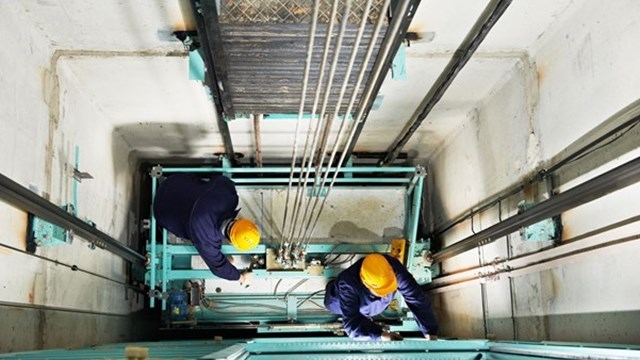It's Chicago, baby. We're talking about the City of Wind. The beloved town by the lake. But what if one of the Second City's famous blustery gusts blows a piece of condominium facade onto some innocent passer-by? This is perhaps the worst-case scenario that could result from either pure happenstance...or from improper or neglected maintenance. While one cannot plan for the former, one can certainly try to avoid the latter—and routine safety inspections as part of a board/ management team's duties to their community are a good step toward doing so.
The first place that an association can turn for the parameters that govern its property is the Chicago Building Code, which is readily available on the city's Department of Buildings website. According to Mimi Simon, the DOB's Director of Public Affairs, the "DOB performs a wide variety of inspections each year to support building safety for occupants and visitors, including annual technical inspections, permit inspections and thousands of inspections in follow-up to complaints coming into the 311 CSR system. The type and frequency of inspections can vary depending on type and age of building, type of equipment in building, use of building and building permits required for maintenance and upgrades."
Simon notes that, as of this past August, city inspectors had completed an estimated 140,000 inspections in 2015 alone, 33,500 of them stemming directly from 311 complaints.
Whodunnit!?
Obviously, says Simon, one size does not fit all when it comes to building inspections in Chicago. The variables range far and wide, but include some specific guidelines designed to ensure that each unique property remains as safe and secure as possible. Steve Welhouse, an attorney with The Sterling Law Group in Chicago, notes that there are more rigorous exterior inspections for properties that are in excess of 83 feet tall, an "admittedly odd number."
"The big concern in the city, in terms of safety inspections, is that there are a lot of old brick buildings, and bricks can fall off those buildings—especially downtown," says Welhouse. "The city has implemented a 'critical examination' of the buildings to be performed every two years, and then there's a more significant inspection that needs be done every four years. And you've got to send an inspection report into the department of buildings for review."
As Simon notes above, while the DOB does perform inspections, they don't perform all of the required inspections on the ground. Jim Stoller, president of property management and real estate service firm The Building Group in Chicago, notes that the city has stepped back from the inspection process over the last several years. "In many cases, you have to hire a licensed architect or engineer to create a report that certifies that the building meets various requirements, and then an association sends that report along to the city," he explains. "The city used to do more of its own on-site inspections, but they've since pulled away in an effort to cut costs. What an association has to do now is hire a professional at its own expense. That professional's license is then on the line, as they're certifying that a property meets the requirements of a specific ordinance. The city has done this for the facade, elevators—many elements of a property. We're seeing a pull-back from physical inspections by city workers in favor of certification by independent experts who have their reputations on the line every time they put a report together."
All that said, Stoller does acknowledge that the city's own inspection aptitude has improved greatly over the past few decades. "Thirty or 40 years ago, inspectors had gone to jail, and people frequently made jokes about pay-offs," he says. "But the new head of the building department is very good, and the professionalism is far greater. Inspectors often come from construction backgrounds, and there's more rigorous training... it's probably the best I've seen in Chicago."
Respect the Process
"It's the responsibility of the building owner to keep his or her building safe,” says Simon, “and in accordance with the Chicago Building Code and other related codes. If a building owner is obtaining a building permit that requires an inspection, that owner is then required to schedule that inspection, along with any required follow-ups, to verify that work is completed according to approved plans. If a building owner fails to schedule an inspection, they could be subject to future building code violations." So the onus is on the association to make sure that it's playing by the rules, at risk of hefty fines, property damage, or—worst case scenario—personal injury.
Welhouse urges associations to be proactive, and to keep track of the periodic inspection cycles, as the city is unlikely to do this for them. "It's possible that a board may receive notices from the city," he says. "But all of the documentation that I've reviewed pertaining to inspections has involved reports prepared by an association's architect or engineer that outline a building's condition/problems/steps to take action."
Having a capable property manager on hand can greatly lessen the difficulty in making sure the various codes and ordinances are properly adhered to. If there's any confusion among an association's administrators as to what needs be done, Stoller recommends starting by having a licensed engineer walk the property, determining what standards apply, what the time frame for inspections is, and so forth. He stresses the ongoing nature of the process, and how a board needs to be engaged throughout.
"The city is mainly interested in whether or not things are dangerous or hazardous," Stoller says. "If there are components that fall into those categories, that's an immediate red flag. A program needs to be put together that needs be addressed either immediately, or within a fairly tight time frame. If there's nothing particularly dangerous or hazardous found, the city will accept the report, and require another inspection done down the line in accordance with a specific schedule."
"The city will work with you," notes Welhouse. "In a lot of cases, depending on the degree of a building's problems, protective scaffold canopies will need to be erected over a sidewalk area, and the city will help with a timetable to make this feasible. The city won't levy a fine immediately, but they'll want to see that some action is being taken—that an association has a plan in place for repairs."
Levies Break
(Associations)
While ferreting out major hazards that can cause damage to persons or property is clearly the main aim of property inspections, there is a wide scope of violations that can cause problems in a condo or co-op property, in either the short term or the long. Dealing with them in proper order is just part of an association's day-to-day, and letting issues fester will almost assuredly cause that issue to get exponentially worse. It's a classic "stitch in time" situation.
In his experience, Welhouse says he has not often encountered an association that didn't take quick action when a violation, or potential violation, was observed by one of its architects or engineers. "Everyone I've dealt with has gotten [their inspections] done on time," he says. Were one to ignore a required repair, that association "would ultimately get in trouble, because the city will inevitably follow up."
"The thing is that there's a wide range of ways an association can go about making repairs," he continues. "That's where differences between associations and their various approaches comes into play. If they do things right, it's going to cost more money up front, but that work doubles as a long-lasting investment in the property. Alternately, they can go the cheap route, and basically smear mortaring onto bricks, but that will last maybe a couple of years. And if it turned out that a property failed to act on something which resulted in someone getting hurt on the street, that would basically be the nuclear option; it would blow it right up. The association would subject itself to a potential multimillion-dollar lawsuit."
For his part, Stoller champions the newer model of having independent contractors report inspections to the city. "It has raised the bar for protection," he says. "It may have cost buildings a pretty penny to get up to the new safety threshold, but, if they can maintain that level, the long-term cost will likely be much less than it would be to deal with any incident. It's always more cost-effective to schedule regular maintenance and repairs, walk the building with professionals and stay on top of your building's status that it is to deal with an emergency."
"Depending on the type of violation,” adds Simon, “the Department of Buildings refers it to Administrative Hearing for enhanced enforcement. In the event that the building code violations are dangerous and hazardous, or if the building owner has failed to correct the violations after a period of time, the building code violations are referred to Circuit Court." And that means expense.
Building inspections are no joke. And while an association can be forgiven for occasionally viewing them as a chore, there's a better outlook to take: inspections are a necessary benchmark that demonstrate that an association is properly taking care of its property, in the interests of its owners, visitors, and the longevity of the building itself. By staying on top of the Building Code and regularly consulting qualified advisers, an association can best ensure that it passes time after time, with really good grades.
Michael Odenthal is a staff writer with The Chicagoland Cooperator.







Comments
Leave a Comment